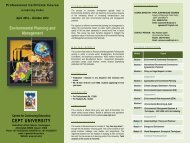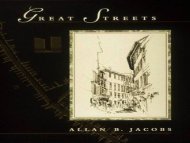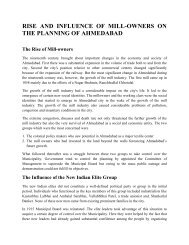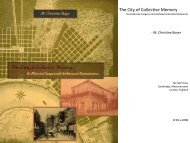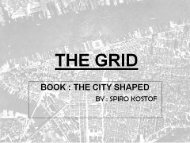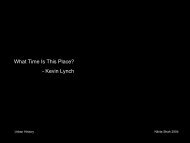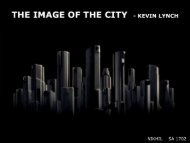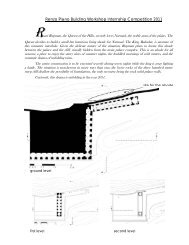BOOK REVIEW adhar talati 3302.pdf
BOOK REVIEW adhar talati 3302.pdf
BOOK REVIEW adhar talati 3302.pdf
You also want an ePaper? Increase the reach of your titles
YUMPU automatically turns print PDFs into web optimized ePapers that Google loves.
<strong>BOOK</strong> <strong>REVIEW</strong><br />
Learning from Las Vegas<br />
UGLY AND ORDINARY ARCHITECTURE, OR THE DECORATED SHED<br />
Robert Venturi<br />
Denise Scott Brown<br />
Steven Izenour<br />
The M.I.T Press<br />
Copyright 1977, 1972<br />
18 th August, 2008 Adhar Talati<br />
Urban History UA 3302
The ironic thing about the idea for the "Duck and the Decorated<br />
Shed," is the fact that the group of Robert Venturi, Denise Scott Brown,<br />
and Steven Izenour admit to an ulterior motive of its invention. They start<br />
by telling us a simple known fact that architects as a rule, tend to<br />
philosophize and write in order to justify their own work. And that they<br />
are no different than the masses of architects, big names and small<br />
names that have come before them.<br />
They define the idea and an exercise in image over process or<br />
form. The part they tell us that is the final 10% of a project but the part<br />
we all see and remember. They talk about the idea of the image being<br />
either similar to or relating to the form or a contradiction to the form,<br />
structure, and program of the building of which they are part. The<br />
exercise will be divided into these manifestations:<br />
1. Where the architectural systems of space, structure, and program are<br />
submerged and distorted by an overall symbolic form. This kind of<br />
building becoming sculpture we call the duck in honor of the duck<br />
shaped drive-in, "The Long Island Duckling," illustrated in God's Own<br />
Junkyard by Peter Blake.<br />
2. Where systems of space and structure are directly at the service of<br />
program, and ornament is applied independently of them. This we call<br />
the decorated shed.
The group opens their discussion with a comparison of two<br />
buildings. They compare a building by themselves, the Guild House and<br />
Paul Rudolph's Crawford Manor. The reason they chose this<br />
comparison, is by virtue that they were built at about the same time, in<br />
similar locals, have similar programs, but express a different image.<br />
They also note that in no way do they say one building is better than the<br />
other, just that they are different.<br />
The differences that are felt to be of the buildings are that the Guild<br />
House has ornament on it and the Crawford Manor does not. On the<br />
Guild House the applied ornament is explicit and at the same time<br />
contrasts and reinforces the building behind it. The stripes of white brick<br />
placed so high on the building gives it a scale of a Renaissance Palazzo.<br />
The scale of the central space in proportion to the whole building creates<br />
the reading of a grand entrance to the palazzo as well. At the top is an<br />
arched window; it is not structural but used as a sign of a different<br />
activity at the top, common space. The location of the arched window,<br />
balconies, and base entry unify the building to a scale of monumental<br />
size rather than layers of apartment units.<br />
`
On the Crawford Manor, such items are unthinkable. It would<br />
never be adorned with expensive materials, white stripes, or<br />
Renaissance compositions. The balconies in this structure that stick out<br />
from the façade are completely integrated into the building rather than<br />
tacked onto it. For the Crawford Manor, the building is understood not<br />
from the adornm of the facade, which is none existent, but from layers of<br />
meaning beyond that of simple facade detailing, the translation of the<br />
elements and their technology to form a building.<br />
The decorated shed is to be understood as signed. The precedent for<br />
this idea of signage is not a new one and can be traced back to some<br />
historical precedent but in modern architecture it is far more prevalent as<br />
a tool and a method of design. The low cost box with the huge sign is<br />
the ultimate expression of this concept and something very prevalent in<br />
building today. It is this idea that was the precedent for the Guild House<br />
and the large sign saying "Guild House" is its most literal interpretation.<br />
This idea of signage, which is something, that can be said to be in every<br />
building is the key to the study. When the sign is literal and spelled out<br />
either by letters or by bold ornaments, we end up with a decorated shed.<br />
On the other hand, when a building is subtly formed and interpreted by<br />
its overall composure, it is then that we have a duck. The question then<br />
gets posed as to which type of building method is the correct one, or<br />
better still which is the accepted one? These questions cannot be<br />
answered simply.



